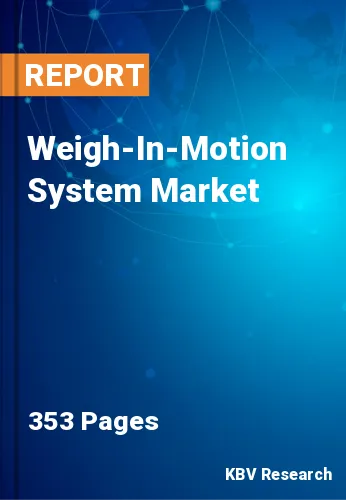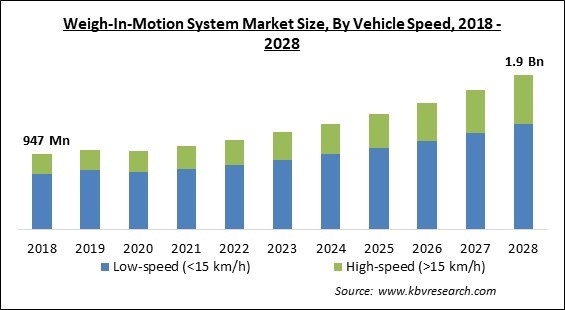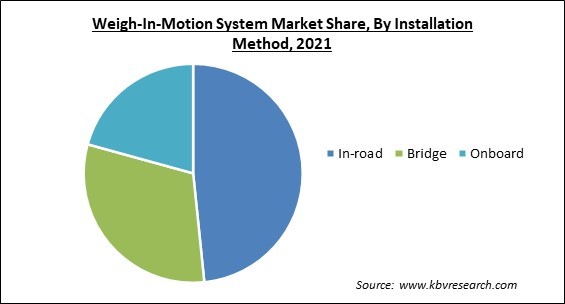
The Global Weigh-In-Motion System Market size is expected to reach $1.9 billion by 2028, rising at a market growth of 9.4% CAGR during the forecast period.
The overwhelming majority of local governments worldwide are embracing smart mobility services aggressively, which is the primary driver behind the launch of initiatives for smart transportation networks by various governments. The drive also plans to complete 34 tasks, such as developing self-driving cars, robotics, taxis, and pedestrian crossings. Another important trend is the development of wireless technologies. This is important because it enables the weigh-in-motion system's deployment without the need for expensive and disruptive building work. It is essential to do this, particularly in remote or hilly areas where installing cables would be difficult or impossible.

Investment in smart cities is also rising as a result of the adoption of creative strategies to enhance productivity, economy, integration, control, sustainability, and efficiency. To promote economic growth, a number of legislators have introduced creative urban programs in various countries. The global development of smart city technology and mobility depends on transportation demand management (TDM). It is anticipated that innovation will play a bigger part in urban neighborhoods as long as ICTs are utilized there. Weigh-in-motion will likely become more necessary in the upcoming years due to the alluring automation opportunities provided by this newly emerging smart transportation.
The WIM systems must operate autonomously in challenging traffic and environmental situations, frequently with no control over how the car is driving or how the driver is acting. Due to these particular measuring requirements, a WIM system deployment requires specialized knowledge and experience.
The unpredictable course of the pandemic makes it challenging for governments to restore the world economy, including trade and tourism, while averting a new wave of the virus. Due to a rapid rise in cases worldwide, lockdowns and sanctions have been redistributed in various nations. The transportation industry was most adversely affected. The travel restrictions implemented in order to stop the disease from spreading hampered organizations’ capacity to transport tourists from wealthier parts of the world and the possibility for advancement. Due to the trade and transportation restrictions, the need for measuring weight and other data regarding vehicles was less. Thus, the market for weigh-in-motion systems has been significantly hit by the transportation sector's enormous decline.
WIM systems are anticipated to be utilized for surveillance and enforcement as well as for forecasting the reasons for congestion. WIM provides toll collection systems, professional services, management systems, traffic forecasting solutions, and systems for booking tickets and doing predictive analysis. For correctly observing and managing traffic, modern tools like streetside sensors, radio wave tags, and GPS systems are also beneficial. As a result, WIM system deployments will happen more frequently to address the growing traffic congestion and transportation management.
In order to make transportation safer, more efficient, and more environmentally friendly, the governments of a number of countries have devised a road map for intelligent transportation infrastructure. This road map calls for the installation of weigh-in-motion systems on highways and other roads for the purpose of collecting data on vehicles, enforcing weight regulations, and charging users based on the vehicle's weight. In order to speed up the process of implementing the same, public-private partnerships are currently being considered. ITS applications provide a more effective transportation network by data processing, combining information, communication, and sensor technology.
Weigh-in-motion systems are one example of a traffic control technology that lacks standardization and uniformity. The weigh-in-motion system is constructed from a variety of hardware and software parts from several suppliers. Additionally, the technical specifications of sensors, CPUs, and other devices differ between manufacturers and are incompatible with various underlying platforms. Additionally, many nations and regions have unique cultural standards and customs that prevent solution providers from offering their services globally. It becomes exceedingly difficult to replace the weigh-in-motion system component in the aftermarket due to a lack of standardization.
By vehicle speed, the weigh-in-motion system market is segmented into low-speed (<15 km/h), high-speed (>15 km/h). The high-speed segment recorded a substantial revenue share in the weigh-in-motion system market in 2021. Verifying road legal weight immediately, operation of weighing completely unattended, daily weighing hundreds of automobiles, and vehicle productivity are the factors that could be tracked in high-speed vehicles by using WIM systems.
Based on installation method, the weigh-in-motion system market is bifurcated into in-road, bridge, and onboard. In 2021, the in-road segment held the highest revenue share in the weigh-in-motion system market. Truck axle weights as well as gross vehicle weights can be recorded using weigh-in-motion (WIM) devices as the truck passes over a sensor. Modern WIM systems are far more efficient because they do not require the subject trucks to stop, unlike previous static weigh stations.
On the basis of technology, the weigh-in-motion system market is classified into load cell, bending plate, piezoelectric sensor and others. The piezoelectric sensor technology segment garnered a substantial revenue share in the weigh-in-motion system market. Piezoelectric sensors have a simpler and more mobile design than other systems. A lower road application depth and a wide measurement system range are further advantages. The piezoelectric polymer sensors typically come in the form of a lengthy cable or tape that is housed inside a big block of elastomeric material.
On the basis of end user, the weigh-in-motion system market is divided into highway toll & road safety, oil & refinery, and logistics & others. The logistics & others segment covered a considerable revenue share in the weigh-in-motion system market in 2021. Before products are transferred to shipping, an automated method called shipping weigh-in-motion is used to check the contents of a carton or container. There is a weight assigned to each customer order, and that weight is determined by the goods in the order.
On the basis of component, the weigh-in-motion system market is segmented into hardware and software. The software & services segment acquired a significant revenue share in the weigh-in-motion system market in 2021. The class file and weight file from WIM stations are used as inputs by this software. The parameters produced by the software after analysis of the input data using some complex mathematical formulas include traffic volume and distribution, general traffic configuration, including the number of axles per truck and the spacing between them; and axle load spectra for various axle types, including single, tandem, and quad axles.
On the basis of application, the weigh-in-motion system market is categorized into weight-based toll collection, weight enforcement, vehicle profiling, traffic data collection, bridge protection and others. In 2021, the traffic data collection segment procured a promising revenue share in the weigh-in-motion system market. Vehicle weights are calculated using weigh-in-motion (WIM) technology while the vehicles are in motion.

| Report Attribute | Details |
|---|---|
| Market size value in 2021 | USD 1 Billion |
| Market size forecast in 2028 | USD 1.9 Billion |
| Base Year | 2021 |
| Historical Period | 2018 to 2020 |
| Forecast Period | 2022 to 2028 |
| Revenue Growth Rate | CAGR of 9.4% from 2022 to 2028 |
| Number of Pages | 353 |
| Number of Tables | 640 |
| Report coverage | Market Trends, Revenue Estimation and Forecast, Segmentation Analysis, Regional and Country Breakdown, Companies Strategic Developments, Company Profiling |
| Segments covered | Component, Vehicle Speed, Installation Method, Technology, End-use, Application, Region |
| Country scope | US, Canada, Mexico, Germany, UK, France, Russia, Spain, Italy, China, Japan, India, South Korea, Singapore, Malaysia, Brazil, Argentina, UAE, Saudi Arabia, South Africa, Nigeria |
| Growth Drivers |
|
| Restraints |
|
Region wise, the weigh-in-motion system market is analyzed across North America, Europe, Asia Pacific, and LAMEA. In 2021, the North America region led the weigh-in-motion market by generating the highest revenue share. The market share for devices in the North American region is increasing as weighing technology develops and the region's heavy-duty vehicle population grows. North America is investing millions in smart city initiatives that will result in smart mobility and offer attractive potential for the expansion of the weigh-in-motion market.
Free Valuable Insights: Global Weigh-In-Motion System Market size to reach USD 1.9 Billion by 2028
The market research report covers the analysis of key stake holders of the market. Key companies profiled in the report include TE Connectivity Ltd., Mettler-Toledo International, Inc., Illinois Tools Works, Inc. (Avery Weigh-Tronix, LLC), Kapsch TrafficCom AG, Q-Free ASA, EFKON GmbH (STRABAG SE), International Road Dynamics, Inc. (WiLAN) (Quarterhill Inc.), Kistler Group (Kistler Holding AG), General Electrodynamics Corporation and Ashbee Systems Ltd.
By Vehicle Speed
By Installation Method
By Technology
By End-use
By Component
By Application
By Geography
The Weigh-In-Motion System Market size is projected to reach USD 1.9 billion by 2028.
Beneficial to road safety are driving the market in coming years, however, Absence of uniform and standardized technologies restraints the growth of the market.
TE Connectivity Ltd., Mettler-Toledo International, Inc., Illinois Tools Works, Inc. (Avery Weigh-Tronix, LLC), Kapsch TrafficCom AG, Q-Free ASA, EFKON GmbH (STRABAG SE), International Road Dynamics, Inc. (WiLAN) (Quarterhill Inc.), Kistler Group (Kistler Holding AG), General Electrodynamics Corporation and Ashbee Systems Ltd.
The Bending Plate market is generating high revenue in the Global Weigh-In-Motion System Market by Technology in 2021; thereby, achieving a market value of $747.5 million by 2028.
The Low-speed (<15 km/h) market is leading the segment in the Global Weigh-In-Motion System Market by Vehicle Speed in 2021; thereby, achieving a market value of $1.3 billion by 2028.
The Asia Pacific market dominated the Global Weigh-In-Motion System Market by Region in 2021; thereby, achieving a market value of $727.8 million by 2028.
Our team of dedicated experts can provide you with attractive expansion opportunities for your business.
